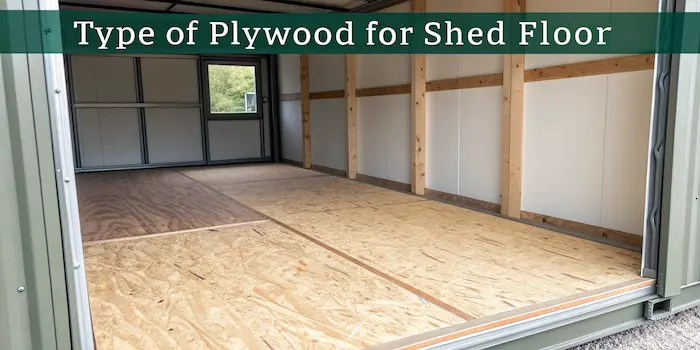Choosing the right plywood for shed floor is essential for durability and longevity. The type of plywood you select impacts the strength, moisture resistance, and overall stability of the shed. Many suppliers provides high-quality plywood that ensures your shed floor remains sturdy and long-lasting.
Why Choose Plywood for Shed Floor?
Plywood is one of the best materials for shed floors because it is strong, affordable, and versatile. It provides a solid base for heavy equipment and withstands various weather conditions. Unlike solid wood, plywood is less likely to warp or crack under extreme conditions, making it a long-lasting flooring solution for sheds. With the right type of plywood, your shed floor can withstand moisture, weight, and environmental changes without significant damage.
Best Types of Plywood for Shed Floor
There are several types of plywood for shed floor to consider. Each type has unique benefits depending on your needs. Choosing the right plywood ensures that your shed floor remains stable, durable, and resistant to damage over time.
1. Pressure-Treated Plywood
Pressure-treated plywood is an excellent choice for shed floors, especially if your shed is exposed to outdoor elements. It undergoes a chemical treatment process that makes it resistant to moisture, pests, and decay. This type of plywood can handle damp conditions and prevent rot, making it ideal for sheds placed on the ground or in humid environments.
2. Exterior-Grade Plywood
Exterior-grade plywood is specifically designed to withstand harsh weather conditions. It is bonded using waterproof adhesives that prevent water penetration, making it highly resistant to rain and humidity. This type of plywood is strong, weather-resistant, and prevents warping and cracking over time.
3. Marine Plywood
Marine plywood is one of the most water-resistant plywood options available. It is made with high-quality waterproof glue and durable wood veneers, ensuring superior protection against moisture and rot. This type of plywood is best suited for sheds in humid or wet climates where constant exposure to moisture is a concern.
4. OSB (Oriented Strand Board)
OSB is a budget-friendly alternative to traditional plywood. It is made by compressing wood strands and adhesives together, creating a strong and durable panel. While OSB provides good strength and support for shed floors, it is not as water-resistant as other plywood options.
If exposed to moisture for extended periods, OSB can swell and degrade. However, when properly sealed and maintained, OSB can be a cost-effective flooring option for sheds that are used for light storage or placed in dry environments.
How to Choose the Right Plywood Thickness?
The answer depends on the shed’s purpose.
- 1/2-inch plywood: Suitable for small, lightweight sheds
- 3/4-inch plywood: Ideal for most sheds, providing better strength
- 1-inch plywood: Best for heavy-duty storage and equipment
MRS Woodcraft recommends using at least 3/4-inch plywood for shed floors to ensure maximum durability and support.
Waterproofing Your Shed Floor
A waterproof shed floor prevents damage from moisture and extends the lifespan of your shed. Here are some effective methods:
- Use waterproof plywood like marine-grade or pressure-treated plywood.
- Seal the edges and surface with waterproof sealants.
- Install a vapor barrier underneath the plywood.
- Elevate the shed floor to prevent water pooling.
Cheap Shed Flooring Ideas
If you’re looking for cheap shed flooring ideas, consider these budget-friendly options:
- OSB board: A cost-effective choice with decent durability.
- Recycled wood pallets: Free or inexpensive but require proper treatment.
- Painted plywood: Adding a layer of waterproof paint enhances durability.
- Vinyl flooring: Affordable, waterproof, and easy to clean.
Installation Tips for Shed Flooring
- Choose high-quality plywood for shed floor from trusted brands like MRS Woodcraft.
- Ensure proper ground leveling before installing the plywood.
- Use screws instead of nails for better hold and durability.
- Apply a waterproof sealant to protect against moisture damage.
- Allow slight expansion gaps to prevent warping.
Conclusion
Selecting the right plywood for shed floor is crucial for a long-lasting and sturdy shed. MRS Woodcraft offers premium-quality plywood that ensures durability, moisture resistance, and strength. Whether you need cheap shed flooring ideas, want to know can I use 1/2 inch plywood for shed floor, or seek a waterproof shed floor, choosing the right plywood makes all the difference.
Frequently Asked Questions? (FAQs)
What Is The Best Plywood For A Shed Floor?
Exterior-grade or pressure-treated plywood from MRS Woodcraft is the best choice for shed floors.
Can I Use 1/2 Inch Plywood For Shed Floor?
It is possible for small sheds, but for better durability, use at least 3/4-inch plywood.
How Can I Make My Shed Floor Waterproof?
Use waterproof plywood, apply sealants, install a vapor barrier, and ensure proper drainage.
What Are Some Cheap Shed Flooring Ideas?
OSB board, recycled pallets, painted plywood, and vinyl flooring are affordable options.
Why Should I Choose MRS Woodcraft Plywood For My Shed Floor?
MRS Woodcraft provides high-quality, durable, and moisture-resistant plywood, ensuring a strong and long-lasting shed floor.

